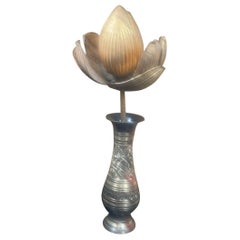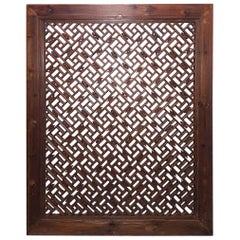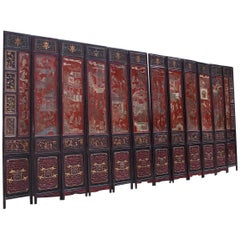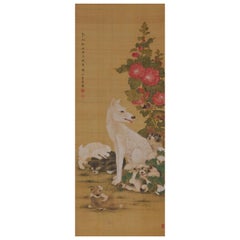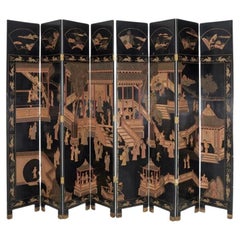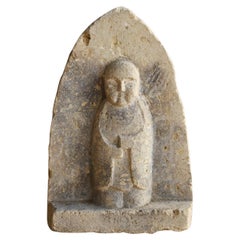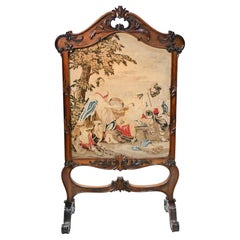1840s Paintings and Screens
4
to
1
3
4
4
4
163
582
893
179
307
217
123
38
4
29
18
14
21
24
22
22
9
3
1
1
1
1
4
4
2
2
Period: 1840s
Japanese Fine Antique Gilt Lotus Bud Flower, Edo Period 19th Century
Located in South Burlington, VT
From our recent Japanese acquisitions, a rare find, stem #3
Antique Original Japanese temple "blossominig lotus" flower bud stem. This finely hand carved wood and lacquered gold flower stem was made for a Buddhist 19th century temple altar...
Category
Japanese Edo Antique 1840s Paintings and Screens
Materials
Wood
Mid-19th Century Peachwood Window Screen from Sianxi, China
Located in New York, NY
An antique window screen from Sianxi, China, Mid-19th Century.
Solid peachwood in dark finish with intricate floral hand-carvings in diagonal p...
Category
Chinese Qing Antique 1840s Paintings and Screens
Materials
Wood
Chinese Coromandel Red Lacquer 12-Panel Figural and Landscape Screen. Circa 1840
Located in Hollywood, SC
Chinese Coromandel figural red lacquer 12-panel screen depicting pagoda and landscape scenes, decorative gilt floral border panels, gilt carved lower panels, and reverse side depicti...
Category
Chinese Chinese Export Antique 1840s Paintings and Screens
Materials
Wood, Giltwood, Lacquer, Paint
1844 - Chichi, Japanese Scroll Painting. Colour on Silk
Located in Kyoto, JP
Mother’s Breast (Chichi) 1844
Hanging scroll. Ink, pigments and gofun on silk.
Inscription:
Kouka era, dragon year, late winter, painted by Shozan Yashou
Artist’ seals:
...
Category
Japanese Edo Antique 1840s Paintings and Screens
Materials
Silk
Related Items
Tall Eight Panel Lacquered Coromandel Chinese Screen
Located in Locust Valley, NY
A tall, eight panel lacquered coromandel Chinese screen. Crafted of enamel and black lacquer, decorated with figures in a court setting. Reverse side depicts flowering plants. Panel...
Category
1840s Paintings and Screens
Materials
Enamel
Japanese antique small Jizo stone Buddha/18th-19th century/Edo period
Located in Sammu-shi, Chiba
This is a small stone Buddha made during the Edo period in Japan.
His dignity is "Jizo Bodhisattva".
She has a cute figure and a gentle face.
It also depicts a lotus flower, with bo...
Category
Japanese Edo Antique 1840s Paintings and Screens
Materials
Stone
Chinese Export Lacquered Four Panel Coromandel Screen
Located in Rio Vista, CA
Beautifully weathered Chinese export four-panel coromandel screen decorated on both sides. The screen features a pavilion landscape on one side and a floral and fauna landscape on th...
Category
Chinese Chinese Export 1840s Paintings and Screens
Materials
Brass
20th Century Black Chinese Lacquered Wood Screen, Vintage Room Divider
Located in West Palm Beach, FL
A black, vintage Chinese screen made of hand crafted lacquered wood, in good condition. The large, detailed Chinoiserie style room divider is co...
Category
Chinese Chinoiserie 1840s Paintings and Screens
Materials
Metal, Brass
No Reserve
H 96.5 in W 144 in D 3 in
Chinese Export Four Panel Carved Soapstone Lacquered Screen
Located in Rio Vista, CA
Distinctive Chinese export four-panel coromandel screen featuring carved hardstone and soapstone decoration. The screen depicts a group of beauties in colorful flowing robes. The parcel-gilt landscape is decorated with two large carved stone trees...
Category
Chinese Chinese Export 1840s Paintings and Screens
Materials
Soapstone, Brass
Chinese Export Lacquered Six Panel Coromandel Landscape Screen
Located in Rio Vista, CA
Beautifully weathered patina Chinese export lacquered coromandel screen with six double sided panels. The screen features a mountain landscape on one si...
Category
Chinese Chinese Export 1840s Paintings and Screens
Materials
Brass
Chinese Export Four Panel Coromandel Screen Pastel Beauties
Located in Rio Vista, CA
Gorgeous Chinese export four-panel coromandel screen featuring a courtyard scene of beauties engaged in leisurely activities. The lacquered panels are incised and painted in soft pas...
Category
Chinese Chinese Export 1840s Paintings and Screens
Materials
Brass
Chinese Export Four Panel Gilt Lacquered Coromandel Screen
Located in Rio Vista, CA
Extraordinary Chinese export four-panel coromandel screen featuring a pagoda pavilion landscape with a dramatic gold leaf background. The black lacquered panels are incised with vibr...
Category
Chinese Chinese Export 1840s Paintings and Screens
Materials
Brass, Gold Leaf
Japanese Edo Period Two-Panel Screen
Located in Stamford, CT
A Japanese Edo Period two panel folding screen with white and brown hawks of ink and color on paper.
Category
Japanese Edo Antique 1840s Paintings and Screens
Materials
Paper
260 Year Old Japanese Hanging Scroll with Painting of the 9-Headed Dragon Deity
Located in Amsterdam, NL
Amazing 260 year old Japanese kakejiku (hanging scroll) with a refined painting of the nine headed dragon deity, with a Buddhist flame as a crown, an...
Category
Japanese Antique 1840s Paintings and Screens
Materials
Metal
Free Shipping
H 35.44 in W 15.99 in D 1.19 in
18th Century Chinese 4 Panel Coromandel Landscape and Figural Screen
Located in Sharon, CT
Offering an early 4 Part carved and lacquered paneled screen, scenes on both sides, each section divided into three parts plus a skirt. Fine carved landscapes on one side and figures...
Category
Chinese Chinese Export Antique 1840s Paintings and Screens
Materials
Lacquer
Chinese Export Gilt Coromandel Screen Manchurian Cranes
Located in Rio Vista, CA
Fantastic Chinese export four-panel lacquered coromandel screen featuring an idyllic pond landscape with eight red crowned cranes or Manchurian cranes...
Category
Chinese Chinese Export 1840s Paintings and Screens
Materials
Gold Leaf, Brass
Previously Available Items
Victorian Tapestry Screen Needlepoint Hand Woven 1840 Pastoral
Located in Potters Bar, GB
Wonderful Victorian tapestry screen showing a delightful English pastoral scene
We date this to circa 1840 and it comes in the mahogany frame which ...
Category
Victorian Antique 1840s Paintings and Screens
Materials
Mahogany
19th Century Japanese Landscape Rinpa School Folding Screen Six Panels Gold Left
Located in Brescia, IT
Landscape with flowering sakura trees of the Edo period.
Six-panel screen painted with mineral pigments and inks on gold leaf from the Rinpa School.
Category
Japanese Edo Antique 1840s Paintings and Screens
Materials
Gold Leaf
H 67.33 in W 149.61 in D 0.79 in
Two Panel Ink and Gold Leaf Japanese Screen
Located in Stamford, CT
Two panel ink and gold leaf Japanese screen depicting water, weeping willows and a blossoming bush. 19th century Edo period in the style of the earlier 17th century Edo period.
Category
Japanese Edo Antique 1840s Paintings and Screens
Materials
Paper
Kishi Ganryo “Flowers of the Four Seasons” Japanese Folding Screen
By Kishi Ganryo
Located in Kyoto, JP
Kishi Ganryo (1798-1852)
“Flowers of the Four Seasons”
Six-panel screen, ink, color and gold leaf on paper.
Inscription: Utanosuke Ganryo
Artist seals:
Ganryo no in
Shiryo
Dimensions:
170 cm x 556 cm (67” x 219”)
Flowers and plants have long held an important role as signifiers of meaning in Japanese culture. Hanakotoba is the Japanese ‘language of flowers’. Essentially, each flower has its own meaning, often based on its physical attributes and/or well known appearances in historical art and literature. This floral screen by Kishi Ganryo is rich with emotional sentiments. The flowers chosen epitomise femininity and the theme is unambiguously romantic. The work was likely commissioned as a dowry gift for a bride.
The screen is ‘read’ from right to left, from spring through to winter. Flowers associated with spring include wisteria, which represents the intoxication of love, bleeding hearts embody femininity and gentleness, and the stem peony timidity and purity. Moving through to summer the pink morning glories represent binding love; they are entwined around tiger lilies which embody prosperity. The white chrysanthemum, an eternal symbol of autumn, represents trust and purity. It is placed next to the cockscomb which stands for emotion and affection. Amongst the pampass grass is the bellflower, which represents unchanging love and honesty. In winter the Nandina flourishes and it is seen as a purifying plant. It is set among bamboo which is a symbol of perseverance and tolerance.
It is highly unusual in that the four seasons are represented on one screen as a complete work of art. Almost invariably spring and summer would be presented on one screen and fall and winter on the matching pair. The screen is also extraordinary in its grand size, measuring 18 feet across. There is a wonderful Japanese sense of composition, revealing just the centre part of the tree-trunk, and the tips of plants and grasses, which gives the impression that you are looking out of a window. In particular the twisting wisteria vines bring to mind Maruyama Okyo’s famous wisteria screens. Against the gold-leaf ground the flowers dazzle with realism. It is a very important and representative work by Ganryo, who was known as a careful observer of nature and talented colorist.
Kishi Ganryo’s given name was Hamatani Masatoshi. He studied painting under Kishi Ganku...
Category
Japanese Edo Antique 1840s Paintings and Screens
Materials
Gold Leaf
Recently Viewed
View AllMore Ways To Browse
Antique Japanese Painting On Silk
Antique Japanese Paintings On Silk
Japanese Panel Folding
Japanese Edo Screens
Chinese Screen Two
Edo Panel
Japanese Pictures
Hand Painted Antique Screen
Vintage Asian Painting
Japanese Meiji Screen
Chinese Panel Lacquered Screen
Antique Door Screen
Antique Screen Doors
Chinese 4 Panel
Carved Window Panels
4 Panel Chinese
Black Lacquer Asian Painting
Asian Lattice
